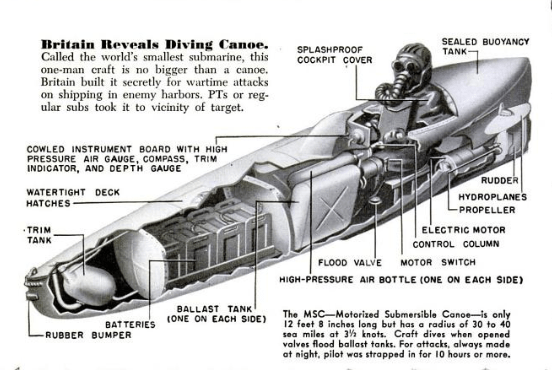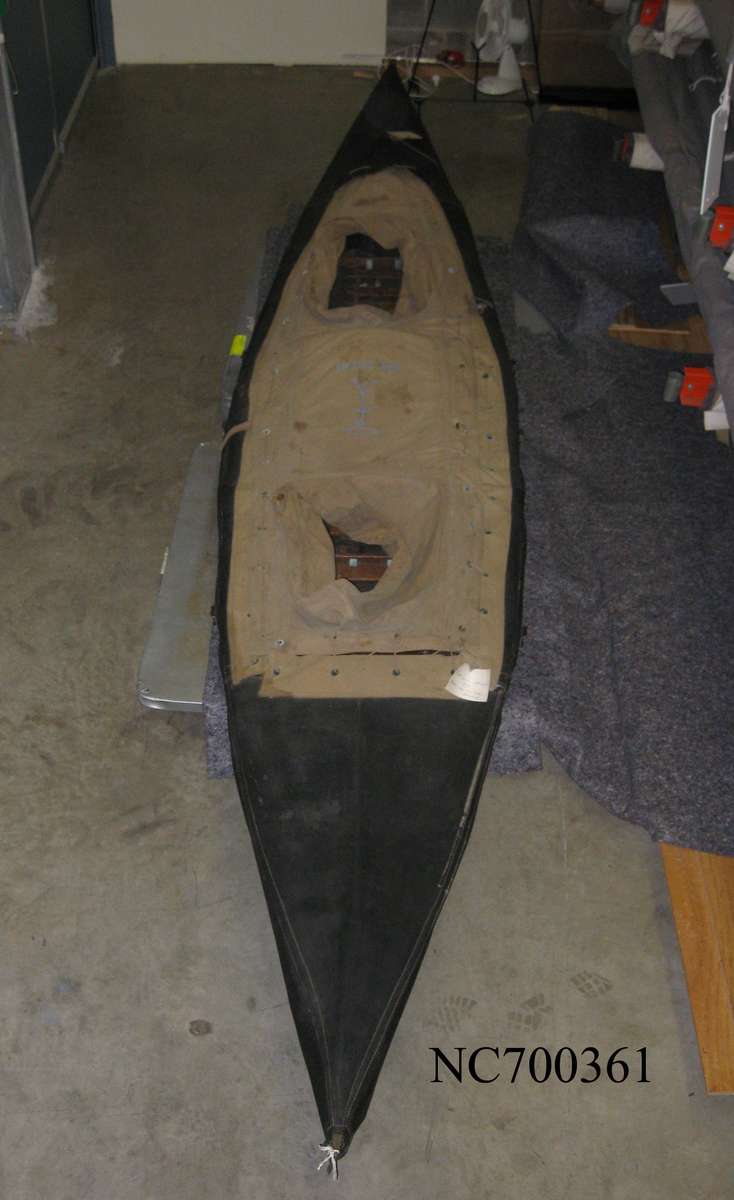
War, for all of its awful consequences, produces some fascinating advances in technology and some very curious inventions. Some have transferred their purposes to civilian society (the modern computer, the humble slinky) but others are too strange, too specialised to have ever left the realm of warfare.
Meet the Sleeping Beauty.
Designed in WWII by prolific British inventor Major H. Quentin Reeves (said to be the inspiration for Ian Fleming’s character ‘Q’ in the James Bond series) of the top-secret research centre Station IX – the Sleeping Beauties were submersible one-man canoes created specifically for the clandestine activities of the Special Operations Executive (SOE) and its offshoot Special Operations Australia (SOA).

Popular Science, March 1947, page 80
Officially known as Motorised Submersible Canoes (MSCs), but nicknamed the Sleeping Beauties, the canoes were designed to perform covert attacks on enemy vessels, allowing operatives to approach their targets submerged and undetected before attaching delayed-action explosives to the hull and making good their escape.

SOA Training Syllabi – Part 8 – ‘Sleeping Beauty Handbook’, page 38. NAA item A3269 Q8/B
The MSCs were made of mild steel and aluminium, were about four metres in length and 70 centimetres wide. They were powered by batteries and an electric 1.5 horsepower starter motor that could produce a top speed of 4.5 knots on the surface and 3.5 knots underwater. The operator wore an underwater suit and breathing apparatus with two hours-worth of oxygen. The MSCs could operate to a maximum depth of about 15 metres and theoretically it was possible to paddle the canoes in the case of an engine failure, however at a weight of 270 kilograms this was not ideal – and probably unachievable.
The craft could also be used for short-range reconnaissance, but were primarily designed for sabotage and could carry up to nine magnetic limpet mines. SB operators would manoeuvre their submerged craft using a joystick and controlled buoyancy through two ballast tanks alongside the driver’s legs. To direct the canoe’s course, a technique known as ‘porpoising’ was employed; taking quick rises to the surface to gain bearings before submerging again. (Check out this US archival footage of an SB enacting an underwater attack.)

Motorised submersible canoe or ‘Sleeping Beauty’ diving about 1945. National Archives UK image DEFE 2/1144A
They were, essentially, a more complicated, and more advanced version of the simple ‘folboat’; two-man canoes that were collapsible, portable, very manoeuvrable and widely used by commando forces during WWII.

Folboat Mark III No. 117 made by Hedleys Pty Ltd in 1943. Same type used during Operation Jaywick. ANMM Collection NC700361
The folboat had famously been employed, to great success, in a September 1943 raid on Singapore Harbour that saw 40,000 tonnes of Japanese shipping damaged or destroyed. Under the auspices of Special Operations Australia and the Z Special Unit, six men in three folboats had paddled stealthily into the harbour under the cover of darkness to attach limpet mines to moored vessels before slipping away again to rendezvous with their main vessel MV Krait.
The success of this raid, codenamed Operation Jaywick, had spurred a second, more ambitious operation, for which new, improved equipment was desired. In March 1944 the leader of Jaywick and its follow-up raid Operation Rimau, Lt-Col Ivan Lyon, travelled to England to view the latest sabotage equipment being produced by SOE and here he was introduced to the newly invented, highly secret, Sleeping Beauty.
Lyon was enthusiastic about the possibilities of the SBs and several canoes were obtained for him and his crew for the upcoming Operation Rimau. SB training for the men was undertaken at Station XIII Careening Bay, Garden Island, Western Australia. Unfortunately the operation was compromised on the approach to Singapore Harbour and Lyon ordered the unused and still top-secret SBs sunk so that they would not fall into enemy hands. The operation ended tragically, with all the operatives either killed or captured and executed by the Japanese.
After Operation Rimau, SOA operatives continued to be trained at Careening Bay in the use of the Sleeping Beauties as well as other curious small submersibles such as the Welman and Welfreighter mini-submarines – however none of the craft appear to have been particularly widely used in the field. The SBs in particular were plagued by technical problems and steering difficulties, with only a few highly-skilled operatives able to handle them efficiently.

Drawing of three submersible craft used by Z Special Unit of SOA in 1944 and 1945. From Top: Welfreighter 4 man submarine, Welman 1 man submarine and Motorised Submersible Canoe (MSC or ‘Sleeping Beauty’. Australian War Memorial item P00908.001
Despite not proving particularly successful for use in the field, the Sleeping Beauties laid the groundwork for later, more advanced naval warfare technology such as the US Navy’s modern Swimmer Delivery Vehicle. More than just a historical oddity or a sideline of human innovation, the development of the Sleeping Beauties are an insight into the fascinating world of our special forces during WWII.
Penny Hyde
This September marks the 70th anniversary of Operation Jaywick and on Tuesday 24th September, the Australian National Maritime Museum will be holding a special event to mark the occasion. Hear about the men who served and book early to have the opportunity to go on board historic vessel MV Krait.
